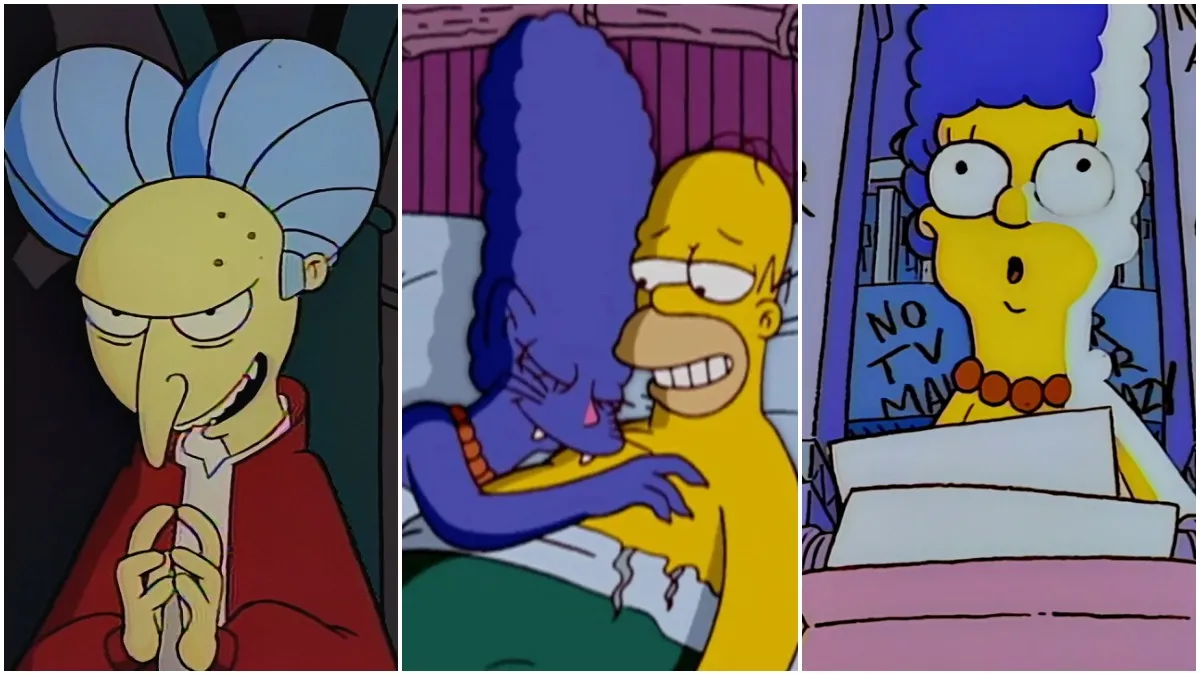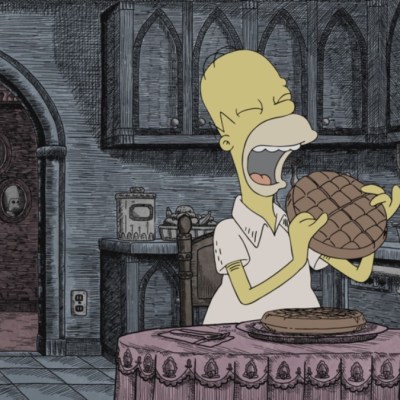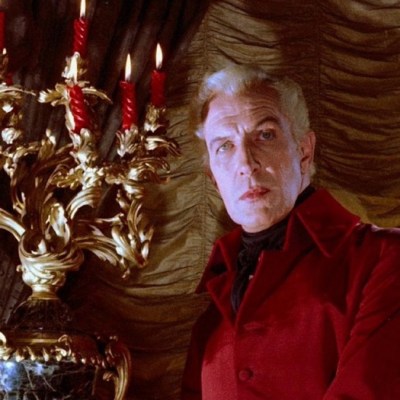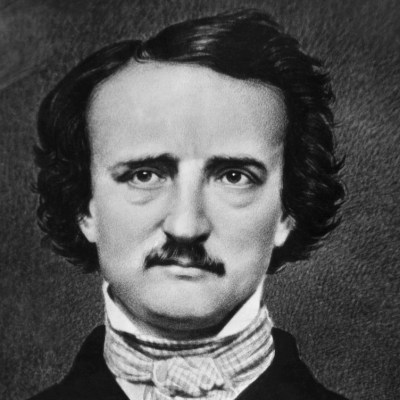The Simpsons’ “Treehouse of Horror” episodes have become a tradition worthy of international renown and global ill repute. They are dark candy for the soul and a grab bag of tricks and treats. The installments are non-canon, so beloved characters can die horribly amusing deaths, and the normal morality plays of America’s most animated family get maimed into cautionary tales of celebration.
The annual Halloween specials draw their inspiration from many sources. Some are ripped from the pages of great books of literature, others are ripoffs of classic films. The long-running series also ventures deep into other dimensions of sound, sight, and mind, of shadow and substance, things and ideas.
Read more
The Simpsons are cultural and their “Treehouse of Horror” segments are cannibalistic. So, grab an empty sack, here are some instances where the series fed on the culture they feed.
6 Twisted Twilight Zone Take-Offs
Submitted for your approval or at least your analysis: The Simpsons, which at 33 seasons, is one of the more visibly worse-for-wear cartoons on Earth. It holds the record for most episodes preempted by football games. It’s very likely the series would continue in precisely this pattern, if it didn’t tempt all the fates by moving into the cold, gray dawn of The Twilight Zone. Rod Serling’s classic anthology series contained all the magic, miracles and technology to keep The Simpsons fresh, funny and twisted, even though the whole family might rather have stood in bed.
We chose six portraits from the night gallery branch of “The Treehouse of Horrors.”
Stop The World, I Want To Goof Off
“A Kind of a Stopwatch” in one of only three Twilight Zone episodes to include the phrase, “submitted for your approval.” It told the story of Patrick Thomas McNulty, fired from his job for stuffing the company suggestion box with meaningless notes, he receives the gift of time. After using and misusing it, he gets handed the bill. “Stop the World, I Want to Goof Off,” from “Treehouse of Horror XIV,” pays it forward with interest. Bart and Milhouse don’t use their magic stopwatch for greed, they just want to make the world a worse place than it is, but in the most comical way.
“Kill them before learning of the terrible secret they possess,”Sideshow Mel yells as the two young pranksters are revealed and reviled, leading to one of those Springfield moments where the whole town assembles for mob rule, and vigilante fun. Bart and Milhouse learn a valuable lesson during the episode, perhaps even more poignant than the one learned on The Twilight Zone. Eating nothing but frosting and giving the Pope a wedgie gets old after a while.
I’ve Grown A Costume On Your Face
Twenty-five bucks won’t buy you half a Balance Bar at the Quik E Mart, but “I’ve Grown a Costume on Your Face” from “Treehouse of Horror XVI” is a reward no witch can rescind. Is it cheating if you win a costume party dressed up as yourself? All of Springfield gets caught up in the fine print when they are cursed to “become the guise thou dons,” which doesn’t clear things up immediately. It is a horrific twist on a last will, and a testament to the power of the façade.
Directed by Ida Lupino, “The Masks” is one of the most subversive and possibly mean-spirited of the Twilight Zone classics. A wealthy man on his deathbed forces his greedy family to wear hideous masks, of his choosing, until the stroke of midnight, when he himself expires. Each mask represents the most unsavory aspect of the wearer, and leaves a lasting impression. Good luck getting your deposits back on those costumes.
Bart’s Nightmare
It’s good that you’re reading this. “Bart’s Nightmare” from “Treehouse of Horror II” is a gift from the iconic Twilight Zone episode, “It’s A Good Life.” Before he got Lost in Space, Billy Mumy found amusement as six-year-old Anthony Fremont. The episode also starred Cloris Leachman as his mother, and her Mrs. Fremont character may be the basis for Marge’s historic run as the most enabling mother on TV. It is good that Bart can do things with his mind, especially considering how he’s usually failing most of his classes.
To see history rewritten around Bart’s whims may be one of those times when The Simpsons predicted the future, but the football announcer praising Bart for a missed field goal scores the most chilling punchline. The segment retains the iconic jack-in-the-box image from the source material, but mainly because it offers so many comic possibilities, and is a must-have on a rollercoaster. The nightmare of the title stems from Dr. Marvin Monroe’s therapy. Just as the sequence is about to coast into something resembling feel-good closure, Bart wakes up screaming, keeping a happy thought.
Clown Without Pity
House of Evil is the best place in Springfield for last-minute birthday gifts. It is the town’s “One Stop Evil Shop,” and specializes in “forbidden objects from places men fear to tread.” They also sell frogurt, a mixed blessing because it is cursed, but comes with free toppings, which are also cursed. When Homer splurges on a rare Krusty doll, even Grandpa Simpson has to admit it is “evil, I tells ya, EEVVILLL!” It is an evil so ancient it goes back to a time when Telly Savalas had hair: the 1963 “Living Doll” episode of The Twilight Zone.
The doll in that episode, Talking Tina, is also Chucky’s cinematic mother, and the funny figurine at the center of “Clown Without Pity” does far more than wait around on staircases to get rid of a dysfunctional dad. The episode also references Trilogy of Terror, and snips the last lingering thread of heterosexuality from Marge’s sister Patty. “Clown Without Pity” was the first segment of “Treehouse of Horror III,” and the writers at the “Krusty the Clown Show” should have claimed it as “Dollhouse of Horror I.”
Terror at 5 1/2 Feet
“Terror at 5 1/2 Feet” from 1993’s “Treehouse of Horror IV,” dismantles the 1963 Twilight Zone episode “Nightmare At 20,000 Feet,” which starred William Shatner. The then-future Captain Kirk only had to deal with a gremlin, and a history of strange behavior. Bart has all that but also loses Milhouse to the iodine-flavored candy treats of the new foreign exchange student Üter. It is a perfect takeoff, hitting all the same beats, but occasionally with more frightening payoffs.
The closeup reveal of the gremlin at the airplane window in the Twilight Zone original is an iconic image. Seeing Groundskeeper Willie forced to take the school bus is more unsettling than what he had to do to his usual carpool. The Simpsons also includes a grislier conclusion, with the gremlin holding the severed head of Ned Flanders, including his spinal column, and still smiling.
Hungry are the Damned
“Hungry are the Damned.” from “Treehouse of Horror I,” is based on the iconic 1962 episode of The Twilight Zone, “To Serve Man.” The installment introduces Kang, Kodos, and Serac, the preparer to The Simpsonsverse, and they came prepared. The Rigelian delegation picks up the Simpson family from a cookout for a greater feast on Rigel 4. To keep the humans engaged during the long trip, the aliens fulfill all their culinary desires, and leave an old book out for them to read.
On the season 3 episode of Twilight Zone, cryptographers work hard and long to decipher the title, but they are halfway through the third course before they realize they are reading a cookbook. Lisa, the most progressive member of the family, exposes her own family as a bunch of xenophobes. Surely, there were monsters on that alien ship, and they over-ate and under-tipped. Hey, whether you’re cooking four humans or 40, Marge is a “quite a dish” in any galaxy.
6 Literary Lacerations
The Simpsons throws the book at their “Treehouse of Horror” chapters like pranksters toss toilet paper rolls into trees on the night before Halloween, the scariest of all nights because that’s when all the last-minute candy grabs are made. The very premise of the annual event is the telling of spooky tales in the limbs of an uncaring twig. Books are made from trees, and every member of the Simpson family has contributed to deforestation. Even Bart Simpson has finished novels. Most of them horror classics, which makes these six picks all the more, and yet much less, literary.
The Island of Dr. Hibbert
Homer can be quite gentle, when he wants to be, but his true nature comes out among the beasts. This “Treehouse of Horror XIII” segment is a parody of The Island of Dr. Moreau by H. G. Wells. In, and on, “The Island of Dr. Hibbert,” Springfield’s resident physician sticks a scalpel into animal husbandry, and Marge is the first bride. “Think what Shakespeare might have accomplished if he had the eyes of an eagle,” Dr. Hibbert enthuses over a sumptuous dinner of hybrid turkey/Professor Frink meat, with chestnut stuffing, rare enough to scream in agony. This is a perfect setup for a discussion about the frightening opportunities in time-shares.
Other than a few Darwinian mishaps, it seems the secret island getaway is an unnatural paradise, as The Simpsons find possibilities untold in Mr. Wells’ story. Homer scratches Marge’s blue panther itches, and questions his humanity. In an animalistic society where all anyone has to do is eat, mate, sleep, mate, eat, wallow in filth for a while, and then eat, mate and sleep again, why is missing out on all the fun?
Easy-Bake Coven
Easy-Bake Coven,” from “Treehouse of Horror VIII,” was rated TV-666. It is vaguely based on Arthur Miller’s 1952 play The Crucible, and its 1996 film adaptation, but is more of a commentary on the times. During a trial scene, Edna Krabappel is wearing a big red letter “A,” which is a nod to the era’s most representational novel The Scarlet Letter. I can’t decide whether the mayor of the town of Sprynge-Fielde, circa 1649, was more or less lenient than the Salem witch trial officiators. Quimby orders the hags burned at the stakes until they are deemed fit to re-enter society. Not precisely a death sentence, but somehow so much worse. “That ought to show God who’s side we’re on,” Ned enthuses at the burning.
When Marge is accused of witchcraft, she gets due process: She’s given a broomstick and shoved off a cliff, if she falls to an honorable Christian death, it proves she’s innocent. If she saves herself by deviltry, she has to return for beheading. Lisa throws the good book at them, pleading for the passage that says “judge not.” Chief Wiggum points out “The Bible says a lot of things.” Upon rising as a witch, Marge vows revenge. Patty and Selma consider stealing everyone’s shoes, but when Ned and Maude fret that witches eat children, the three witches set off to sack Rod and Todd. When the Flanders trade sweets for tots, it becomes the story of the first caramel cod. It’s too bad the Bouvier sisters filled up on children. One historical note, Hasbro’s Easy-Bake Oven was not available in the new world in 1649.
Bart Simpson’s Dracula
1993’s “Treehouse of Horror IV” closed the coffin on Bram Stoker’s Dracula, and all the works and pomps which the man who made The Godfather brought to its film adaptation. Stoker was not known as a humorist, and the first draft of his play Dracula was so boring the actor playing the title role fell asleep at the table read, something Abe Simpson emulates consistently. Stoker’s book mentions dark shadows which Francis Ford Coppola masterfully transposed to the screen, but they are nowhere near as imaginative as the spectral clouds the plasma-deprived dark prince of Pennsylvania, C. Montgomery Burns, throws onto the walls. The only things more insidious are what he utters into the intercom when he thinks he’s taken his fingers off the button.
“Bart Simpson’s Dracula” is actually rather loosely based on the book “Yes, I am a Vampire,” by Monty Burns, with a forward by Steve Allen. It also borrows from Stephen King’s Salem’s Lot, when Bart and the Springfield Elementary School gang start hanging by invisible thread outside Lisa’s window. The most disturbing detail doesn’t come with the revealing of the head vampire, but with the power of the eternal boss. Homer gets fired for plunging a stake into Burns’ heart.
The Devil and Homer Simpson
Hell hath no fury which can smite a hungry, hungry Homer. Homer Simpson sells his soul for a donut and breaks Hell’s kitchen when his first punishment is to be force-fed an endless supply at the Ironic Punishment division at Hell Labs. This “Treehouse of Horror IV” installment, from 1993, is based on “The Devil and Daniel Webster,” a 1936 short story by Stephen Vincent Benét. His father and grandfather were military brass, and packed him off to the aptly named Hitchcock Military Academy when he was ten.
“Who’s that goat-legged fellow? I like the cut of his jib,” the eternally condemned Mr. Burns muses upon seeing the infernal one materialize on the Nuclear Plant security monitor. In the 1941 film adaptation, the lovable Walter Huston played Mr. Scratch. The primary titular character in “The Devil and Homer Simpson” is played by Homer’s god-fearing neighborino: “Hens love roosters, geese love ganders, everyone else loves Ned Flanders.” In his defense, the donut which first tempted Homer was “a vision in raspberry cream.” Sadly, the infernal court-appointed Defense Attorney Lionel Hutz, voiced by Phil Hartman, was too busy watching Matlock to even glance at discovery. With a “jury of the damned” consisting of Lizzie Borden, Benedict Arnold, John Wilkes Booth, Blackbeard the Pirate, John Dillinger, Richard Nixon, and the starting line of the 1976 Philadelphia Flyers, Homer wins but is still served unjust desserts.
Time And Punishment
I don’t want to be the negative Nellie in Sector 2, but the only thing “Time and Punishment” has in common with Fyodor Dostoevsky’s epic morality meditation Crime and Punishment is the title, and the eternal questions of endless existence. Yes, it took Homer forever to read that book, and if it wasn’t for a magical time machine-traveling toaster, and a stint in the waiting room for re-Neducation he never would have finished.
In the novel, the rascally Rodion Raskolnikov gets away with killing a pawnbroker, only to confess his crime and go to prison. In this installment from season 6’s “Treehouse of Horror V,” Homer kills all life on earth with a sneeze, tries to tell it to his family, and misses out on a mid-afternoon donut shower. He also is robbed of the chance to kill Groundskeeper Willie. Maggie gets the traditional honor in a particularly disturbing universe.
The Raven
The Simpsons’ “The Raven” is the most faithful adaptation of Edgar Allen Poe’s poetic masterpiece ever produced. In the 1935 film adaptation of The Raven, Bela Lugosi gives killer-on-the-run Boris Karloff a fearsome facelift. The 1963 film of the same name cages Karloff with Vincent Price and Peter Lorre as a trio of sorcerers. The 2012 film The Raven is about watching Poe die. Narrated by Lisa in her head voice, James Earl Jones, this installment in “Treehouse of Horror I” is a word-for-word retelling.
Read more
Homer is the tortured insomniac, distracted by every purple curtain, and pining for the lost Lenore, played by a two-tiered portrait of Marge. The telling captures the suspense of Poe’s interior rhymes, building to its most ironic climax. “You know what would have been scarier than nothing,” Bart asks. “Anything.” The actual black bird, played by Bart, is precisely the craven presence Poe imagined. The raven is a reminder so incessant it drives Homer to madness.
6 Segments That Mock Movies
From the very first Halloween special, The Simpsons have looked to motion pictures for morbid inspiration. They have mined horror, suspense and science fiction films for some of their most frighteningly funny farces, and veiled insubordination. The Simpsons find mischief in the most classic motion pictures. We picked six segments which capture the most sinister cinema moments.
Bad Dream House
Be it ever so humble, there really is no place like the “Bad Dream House,” except maybe the dwellings of Poltergeist and The Amityville Horror. Prime location, 18 bedrooms, a mote, and a portal to another dimension in the kitchen, the Simpsons wouldn’t have been able to afford the house if its walls didn’t bleed. Flashlight please, this was the first “Treehouse of Horror” segment ever aired, and the most scarifying.
The twist is, the Simpson family haunts the spooks. They don’t realize it, of course, even when the house sets each of the family against each other in an endless parade of knives, axes, white bread and mayonnaise. Given an ultimatum never before promised in a haunted house story, the dwelling chooses to destroy itself rather than spend eternity with the Simpsons. “You can’t help but feel a little rejected,” Lisa Simpson observes.
Nightmare Cafeteria
While the gang in The Breakfast Club were also stuck in detention, “Nightmare Cafeteria,” is Lunch Lady Doris’ way of making “Grade F” Soylent Green taste good. Springfield Elementary solves its bad meat problem with bad eggs, as Principal Skinner prepares tomorrow’s lunch with today’s detainees. Jimbo is a little tough, but free-range children are fairly game.
The third segment of “Treehouse of Horror V” was all about the children – sliced, diced, and blended into a saucy puree. When Springfield Elementary faces budget cuts and overcrowding, the teachers say “supersize me.” Skinner gets the honor of continuing the Treehouse of Horror tradition of axing Groundskeeper Willie in the back. The episode dishes out delicious bad taste.
Nightmare On Evergreen Terrace
“Nightmare On Evergreen Terrace” opens on the 13th day of the 13th month, according to the misprinted calendars Springfield Elementary bought. That’s not the only item the school scrimped on. They also cut costs on boiler room maintenance, door-knob repairs, and the refilling of fire extinguishers, which the Fire Department was offering for free. All of this combines to take a fiery toll on Groundskeeper Willie, who begins the segment as a plaid-clad Freddy Krueger in a Nightmare on Elm Street spoof, only to have his bagpipes popped in the deadlights of a parody of Stephen King’s It.
“Nightmare On Evergreen Terrace” is a dream of an episode, with colorful demises, and excellent set gags. Martin’s death with the tongue-lashing Calliope is a wonderfully twisted visual homage. Aired as segment 2 of “Treehouse of Horror VI” during season 7, it is also marked by Groundskeeper Willie’s truly ingenious creations, and the hysterically anticlimactic finish.
“The Shinning”
The Overlook Hotel in both Stephen King and Stanley Kubrick’s The Shining is a lot of fun in the summer, and a nightmare in the winter. Mr. Burns’ mountain lodge, in the “Treehouse of Horror V” segment, is built on an Indian burial ground, and was the site of satanic rituals, witch burnings, and the recordings of five John Denver Christmas specials. But the horrors don’t end there. There are no liquor deliveries during the off-season, and the vacation mansion turns off the cable after the fall premieres. Burns is so sure this isn’t the reason the past few downtime caretakers have all gone homicidally insane, he promises Smithers “if we come back and everyone’s slaughtered, I owe you a coke.”
“The Shinning” is such a perfect parody the writers had to add an extra “n” to the title to avoid a copyright dispute. It may be the best King adaptation yet made. It’s scary, funny, and has an ending we can all relate to. “Come, family. Sit in the snow with daddy and let us all bask in television’s warm glowing warming glow,” Homer says before all the Simpsons gather for one last infomercial. All work and no play makes us all something something.
Citizen Kang
“Abortions for some, miniature American flags for others,” we are promised in “Citizen Kang” from “Treehouse of Horror VII.” The film which inspired it is Citizen Kane, but the candidates are no rosebuds. Like Charles Foster Kane, citizens Kang and his sister Kodos don’t care if Springfield loses a million dollars a year, they only want your vote. Having reached the limits of what can be gleaned from humans via anal probe, they’ve commenced bio-duplication in time for the election. They are well-versed in pandering, flip-flopping, and how to excuse the exchange of long protein strings in public.
The segment has alien invasions, nude conspiracies, and proves what Lyndon LaRouche had been saying all along. It was timely at the time, the 1996 presidential race between Bill Clinton and Bob Dole, and seems quaint now. But it is no less funny, and never more true. “It makes no difference which one of us you vote for,” candidate Kang explains. “Your planet is doomed. Doomed.” Don’t blame us if you’ve thrown your vote away on a third-party candidate. I voted for Kodos.
A Streetcar Named Marge
The most frightening moment on The Simpsons occurred outside of the “Treehouse of Horrors” presentation. While Marge takes to the stage as Blanche Dubois in the 1992 episode “A Streetcar Named Marge,” Maggie is kept at The Ayn Rand School for Tots daycare center. It is a frightening and ominous place with such mindful reminders as “Helping is Futile,” and the children are fed “The Fountainhead Diet.”
The final scene where the family is retrieving Maggie is an homage to the film The Birds, and even contains one of Alfred Hitchcock’s patented cameos. The director was known for making uncredited appearances in his films. He misses a bus in North by Northwest, hides under a cowboy hat in Psycho, and I want to say he is one of the birds in The Birds, but he’s actually a guy walking a dog. Whether or not he’s also playing the dog, I don’t know. But he repeats his appearance as Homer is sneaking Maggie out of daycare. Hitchcock would also make an appearance in the “Treehouse of Horror” segment, “Dial “M” for Murder or Press “#” to Return to Main Menu.” A is A,” they say in Atlas Shrugged.




